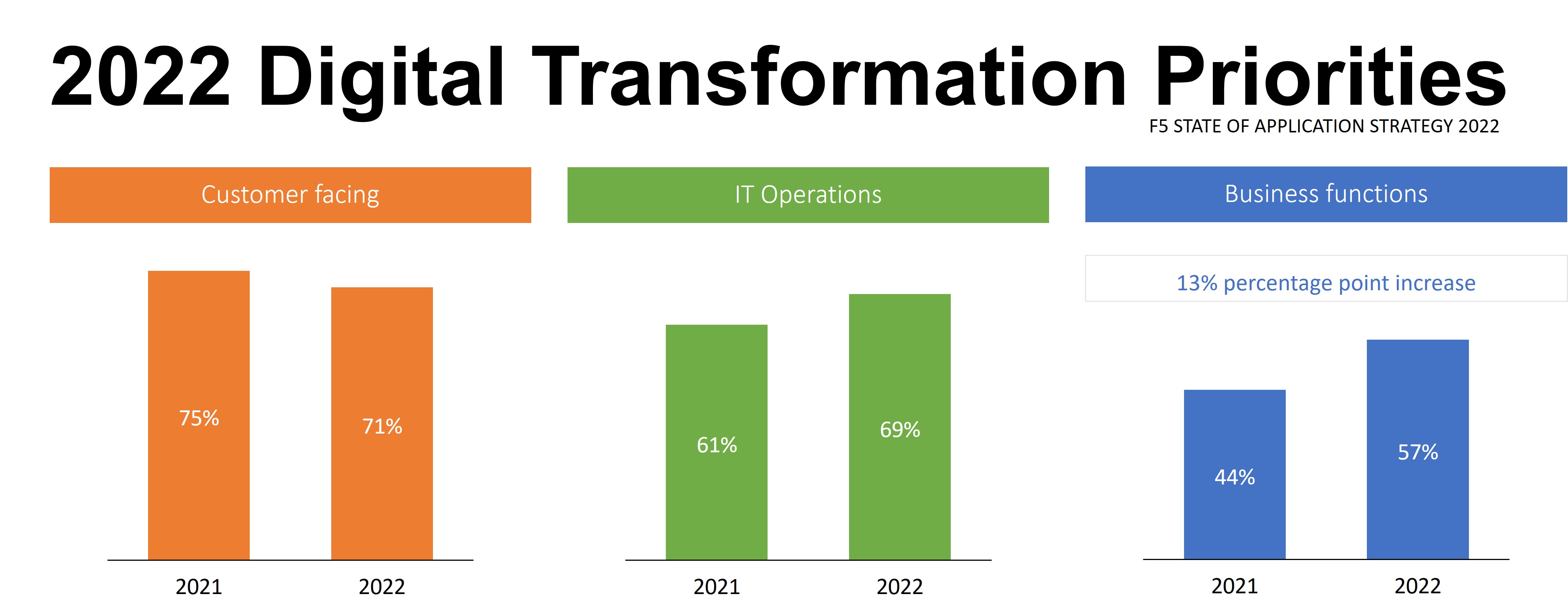Las funciones legales son finalmente una prioridad para la transformación digital en 2022
El foco de la transformación digital se está desplazando hacia las funciones ocultas (back-office) necesarias para digitalizar completamente la experiencia del cliente. Tanto las funciones de RR.HH. como las financieras están recibiendo una atención cada vez mayor en comparación con los años anteriores y las funciones legales están recibiendo una atención aún más necesaria.

Las funciones de atención al cliente siguen siendo una prioridad, pero estamos viendo que las operaciones de TI y las funciones comerciales se están volviendo cada vez más importantes. Esto no es sorprendente, ya que la COVID impulsó la rápida digitalización de todos los aspectos de la vida y obligó a las organizaciones a apostar todo por la experiencia del cliente.
Pero lo que vemos ahora es que las organizaciones se encuentran con obstáculos en su camino transformación digital . Han digitalizado la experiencia del cliente externo, pero no han dedicado mucho trabajo a la gran cantidad de funciones internas necesarias para respaldar esa experiencia.
Insertar pasos manuales en papel en medio de una experiencia digital automatizada la ralentiza e introduce la posibilidad de error humano. Así que han comenzado a centrarse en digitalizar tareas internas a través de aplicaciones. Este enfoque impacta todas las áreas del negocio. El diecinueve por ciento de las organizaciones están digitalizando las funciones legales. Si esto parece extraño, considere que las preocupaciones legales afectan muchos aspectos de los negocios que tratan con el cliente, tales como acuerdos, contratos, suscripciones, compras y reembolsos, así como las capacidades internas con respecto a la contratación, las adquisiciones, la incorporación de proveedores y la gestión de carteras de patentes. Esta es una de las razones por las que vemos un aumento en las organizaciones que participan en la fase uno; han “comenzado de nuevo” con funciones de líneas de negocio que siguen siendo manuales y basadas en papel.
Por qué las funciones jurídicas de las empresas son fundamentales para el éxito
La atención sanitaria se ha vuelto digital. Según la encuesta “Most Wired” del College of Healthcare Information Management Executives , en 2021 “el uso y la adopción de la telesalud siguieron aumentando en general, pero la curva de crecimiento se estabilizó con respecto a la curva más pronunciada de 2020. El uso informado (medido por el porcentaje de pacientes que utilizaron la telesalud en cada centro) se ha más que duplicado desde 2019”. Y BDO, en su Encuesta de Transformación Digital de Atención Médica de 2021, descubrió que el 75% invirtió en telemedicina, el 64% en interoperabilidad HER y el 56% en portales de pacientes.
Esos portales de pacientes son excelentes, pero muchos aún carecen de soporte digital para funciones legales y regulatorias. Estas aplicaciones web y móviles ofrecen una experiencia principalmente digital, pero pueden encontrarse con obstáculos tanto de HIPAA como de COPPA. Por ejemplo, pude registrarme y recibir los resultados de mi prueba de COVID a través de un portal de pacientes en cuestión de minutos. Pero para obtener los resultados de mi hijo adolescente tuve que llamar a una enfermera. Esto se debe a que el proceso para autorizar el acceso de un padre a los registros digitales requiere completar un formulario en papel, firmado por el menor y enviado físicamente por correo al proveedor de atención médica. Se supone que a partir de ahí se escanea, se almacena y se asocia con los permisos pertinentes a los registros.
No hace falta decir que el proceso llevaría días, o incluso semanas, cuando necesitaba esos resultados en horas.
Es por esto que los resultados de nuestra encuesta anual fueron tan emocionantes, y por eso un cambio en las prioridades de la transformación digital hacia funciones comerciales como la legal también debería entusiasmarle a usted. Incluso digitalizar todos los pasos de un proceso excepto uno solo conducirá, en el peor de los casos, al fracaso y, en el mejor de los casos, a la frustración. Es como conducir un coche por todo el país y luego detenerse para cruzar caminando todo el estado. Si eso suena ridículo, entonces verá por qué replicar efectivamente esa ineficiencia en un flujo de trabajo digital es igualmente inimaginable.
Toda función empresarial que afecte, de cualquier manera, la experiencia del cliente debe estar completamente digitalizada para ofrecer con éxito una experiencia digital extraordinaria. Esto significa que las funciones legales son tan importantes como las interfaces web y las aplicaciones móviles.
Este hallazgo es sólo uno de los muchos resultados apasionantes y a veces sorprendentes que descubrimos durante el análisis de nuestra investigación anual. Espero compartir esos descubrimientos y conocimientos con ustedes cuando publiquemos el Informe sobre el estado de la estrategia de aplicación 2022 en marzo.
Si no puede esperar, la increíble Cindy Borovick y yo le ofreceremos un adelanto de los resultados en nuestra conferencia anual, Agility , en febrero. Es gratuito y virtual y serás el primero en conocer nuestras sorprendentes ideas antes que nadie.
Y como siempre, esté atento a este espacio para obtener próximos blogs con datos y análisis que no encontrará en el informe oficial.
